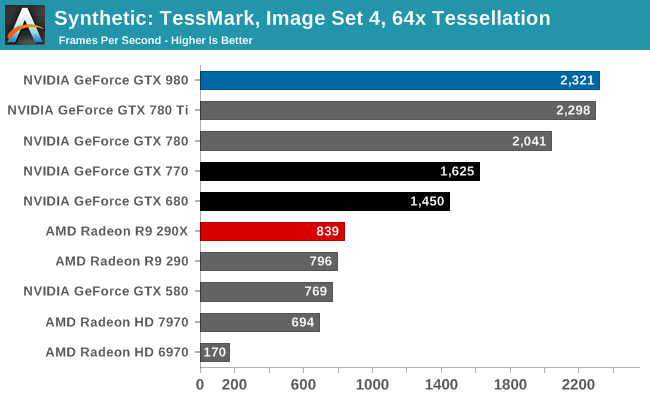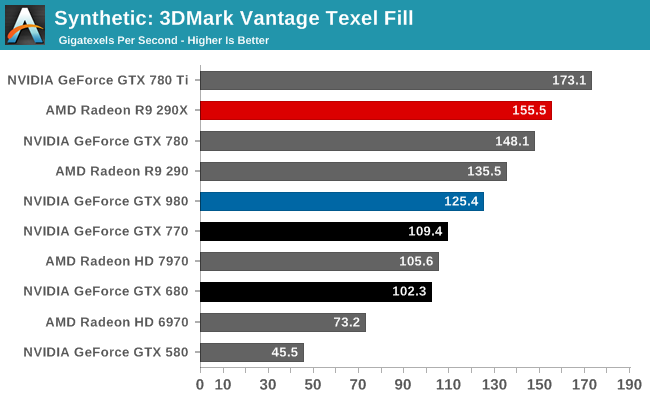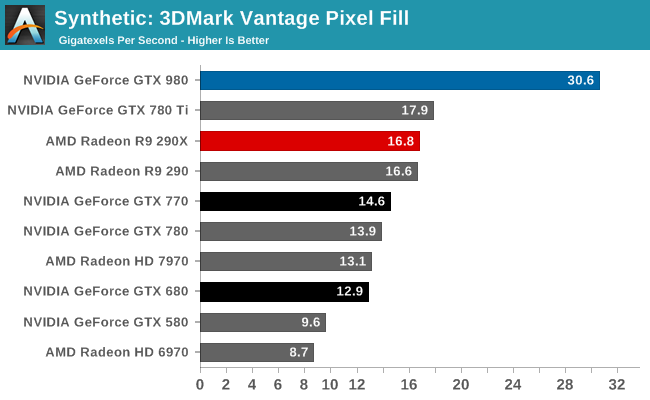The NVIDIA GeForce GTX 980 Review: Maxwell Mark 2
by Ryan Smith on September 18, 2014 10:30 PM ESTSynthetics
As always we’ll also take a quick look at synthetic performance. These tests mainly serve as a canary for finding important architectural changes, and with the exception of pixel throughput we are not expecting any major changes for GTX 980 and GM204.

GM204 is designed to have an ever-so-slightly higher triangle throughput rate than GK110 – 16 tris/clock versus 15 tris/clock, and sure enough the GTX 980 comes out on top in TessMark, slightly edging out the GTX 780 Ti. The difference is only very slight here, and though GM204 should be a bit more powerful than GK110 in practice it’s a dead heat.
Moving on, we have our 3DMark Vantage texture and pixel fillrate tests, which present our cards with massive amounts of texturing and color blending work. These aren’t results we suggest comparing across different vendors, but they’re good for tracking improvements and changes within a single product family.

Beginning with Maxwell NVIDIA reduced their texture-to-compute ratio from 12:1 to 16:1. As a result of this change Maxwell GPUs have fewer texture units than comparable Kepler GPUs. Compounding this effect is the fact that Maxwell CUDA cores are more efficient than Kepler CUDA cores, leading to NVIDIA placing fewer cores overall and further reducing the texture fill rate.
As a result the GTX 980 is not texture fillrate competitive with any of the GK110 cards. It is competitive with the GK104 cards, but only because these cards had the same number of texture units at 128. NVIDIA has told us that they believe this new ratio is a better fit for modern workloads, and judging from the performance we’re seeing elsewhere it would appear that NVIDIA is right.

On the other hand, thanks to NVIDIA’s newer 3rd generation delta color compression technology, our 3DMark pixel fillrate performance is through the roof. GTX 980 comes very close to doubling the throughput of our GK110 cards and more than doubles the throughput of the GK104 cards, reflecting the fact that it has 64 ROPs and more importantly has the available bandwidth to put them to good use.
This benchmark in a nutshell is why NVIDIA can deliver chart-topping performance despite having only 2/3rds the memory bandwidth of GTX 780 Ti. By improving their color compression to this point, NVIDIA can significantly reduce their memory bandwidth requirements Maxwell 2, allowing them to do more with less. In real games the result won’t be anywhere near this remarkable since this is a pure pixel fillrate test, but it goes to show that NVIDIA has been able to expand their effective memory bandwidth in concert with their ROP and shader performance improvements.










274 Comments
View All Comments
bernstein - Friday, September 19, 2014 - link
it's nice having one article with a full review, & it's nice to have early partial results... so in the future if publishing with missing content PLZ put in a big fat bold disclaimer:xyz content missing, update coming on 2.2.2222
chizow - Friday, September 19, 2014 - link
@Ryan, thanks for the update, sorry I just scanned through and didn't see the subtext mentioning your issues with the 970. Looking forward to updated results once you get some good samples.nevertell - Friday, September 19, 2014 - link
You can't read through the article in one sitting yet you complain about the article being rushed ?chizow - Sunday, September 21, 2014 - link
@nevertell, not sure if that comment was directed at me, but I never read through the entire article in the first sitting, especially in this case where I was actually in the market to buy one of these cards and might need to make a quick buying decision. I generally look at results and jump around a bit before going back to read the entire article, and I did not see any subtext on why the 970 wasn't included on this page about "Launching Today":http://www.anandtech.com/show/8526/nvidia-geforce-...
I expected to see something about why the 970 wasn't launching today, staggered launch, didn't get review sample etc but did not see anything, so I asked bc I saw Ryan was attending the comments here and might get a quick response.
boot318 - Thursday, September 18, 2014 - link
Bye, AMD!Amazing card(s) Nvidia bought to market! I've already seen a couple of reviews showing this monster overclocking over 1450+. Just think about when Nvidia drops a big die version........ :)
dragonsqrrl - Thursday, September 18, 2014 - link
AMD is by no means out of it. They're still very competitive in terms of performance, however they're far behind in terms of efficiency, which means to compete with the 980 they'll likely have to launch a far higher TDP card that requires more exotic cooling and will almost certainly be more expensive to manufacture. Even when you take the 285 into consideration, which offers 280 level performance at greatly reduced TDP, it's still at a higher TDP then the 980 which now outperforms the 290X by ~15%. And this isn't even taking noise, build quality, or features into consideration... Not a good position for AMD, in fact it's somewhat reminiscent of their processors (minus the competitive performance part)."Just think about when Nvidia drops a big die version........ :)"
Fortunately for AMD that's just not going to happen on 28nm, otherwise I might be inclined to agree with you. They still have a very real competitive chance with their upcoming cards.
arbit3r - Thursday, September 18, 2014 - link
O god really? 285 has greately reduced TDP? um 280 had a 200watt TDP, the 285 is 190, 10 watts less i wouldn't call that greatly reduced. Before you say 280 had 250watt tdp, no that is the 280x.dragonsqrrl - Friday, September 19, 2014 - link
I haven't done much searching around, but according to Anandtech's review of the 285, the 280 has a 250W TDP.http://www.anandtech.com/show/8460/amd-radeon-r9-2...
arbit3r - Friday, September 19, 2014 - link
plenty sites i know of say its 200, so if there is that much misinfo then likely AMD at fault for that one. Seeing a lot of reviews put real world power usage around 20watts difference.Ryan Smith - Friday, September 19, 2014 - link
For the record, 250W for R9 280 comes directly from AMD's reviewer's guide for that product.